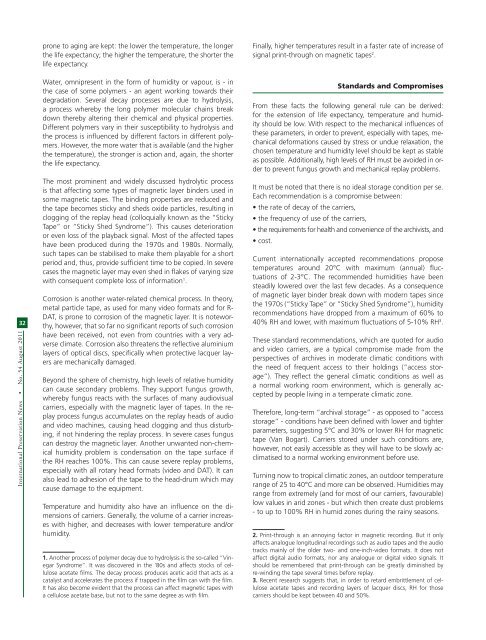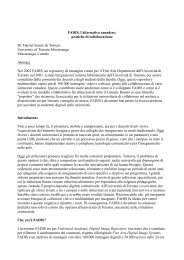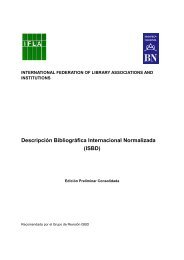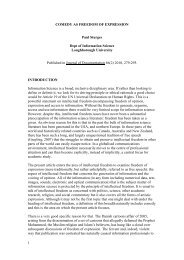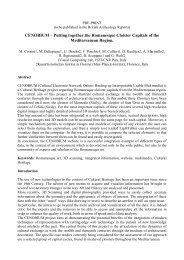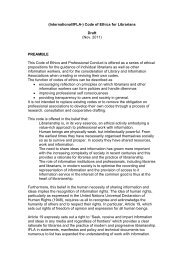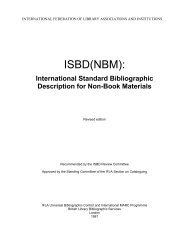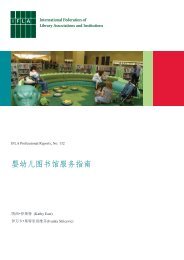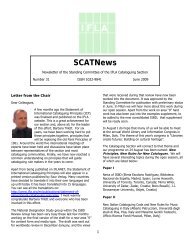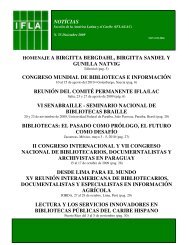N o 54 - IFLA
N o 54 - IFLA
N o 54 - IFLA
Create successful ePaper yourself
Turn your PDF publications into a flip-book with our unique Google optimized e-Paper software.
prone to aging are kept: the lower the temperature, the longer<br />
the life expectancy; the higher the temperature, the shorter the<br />
life expectancy.<br />
Finally, higher temperatures result in a faster rate of increase of<br />
signal print-through on magnetic tapes 2 .<br />
32<br />
International Preservation News • No. <strong>54</strong> August 2011<br />
Water, omnipresent in the form of humidity or vapour, is - in<br />
the case of some polymers - an agent working towards their<br />
degradation. Several decay processes are due to hydrolysis,<br />
a process whereby the long polymer molecular chains break<br />
down thereby altering their chemical and physical properties.<br />
Different polymers vary in their susceptibility to hydrolysis and<br />
the process is influenced by different factors in different polymers.<br />
However, the more water that is available (and the higher<br />
the temperature), the stronger is action and, again, the shorter<br />
the life expectancy.<br />
The most prominent and widely discussed hydrolytic process<br />
is that affecting some types of magnetic layer binders used in<br />
some magnetic tapes. The binding properties are reduced and<br />
the tape becomes sticky and sheds oxide particles, resulting in<br />
clogging of the replay head (colloquially known as the “Sticky<br />
Tape” or “Sticky Shed Syndrome”). This causes deterioration<br />
or even loss of the playback signal. Most of the affected tapes<br />
have been produced during the 1970s and 1980s. Normally,<br />
such tapes can be stabilised to make them playable for a short<br />
period and, thus, provide sufficient time to be copied. In severe<br />
cases the magnetic layer may even shed in flakes of varying size<br />
with consequent complete loss of information 1 .<br />
Corrosion is another water-related chemical process. In theory,<br />
metal particle tape, as used for many video formats and for R-<br />
DAT, is prone to corrosion of the magnetic layer. It is noteworthy,<br />
however, that so far no significant reports of such corrosion<br />
have been received, not even from countries with a very adverse<br />
climate. Corrosion also threatens the reflective aluminium<br />
layers of optical discs, specifically when protective lacquer layers<br />
are mechanically damaged.<br />
Beyond the sphere of chemistry, high levels of relative humidity<br />
can cause secondary problems. They support fungus growth,<br />
whereby fungus reacts with the surfaces of many audiovisual<br />
carriers, especially with the magnetic layer of tapes. In the replay<br />
process fungus accumulates on the replay heads of audio<br />
and video machines, causing head clogging and thus disturbing,<br />
if not hindering the replay process. In severe cases fungus<br />
can destroy the magnetic layer. Another unwanted non-chemical<br />
humidity problem is condensation on the tape surface if<br />
the RH reaches 100%. This can cause severe replay problems,<br />
especially with all rotary head formats (video and DAT). It can<br />
also lead to adhesion of the tape to the head-drum which may<br />
cause damage to the equipment.<br />
Temperature and humidity also have an influence on the dimensions<br />
of carriers. Generally, the volume of a carrier increases<br />
with higher, and decreases with lower temperature and/or<br />
humidity.<br />
1. Another process of polymer decay due to hydrolysis is the so-called “Vinegar<br />
Syndrome”. It was discovered in the ‘80s and affects stocks of cellulose<br />
acetate films. The decay process produces acetic acid that acts as a<br />
catalyst and accelerates the process if trapped in the film can with the film.<br />
It has also become evident that the process can affect magnetic tapes with<br />
a cellulose acetate base, but not to the same degree as with film.<br />
Standards and Compromises<br />
From these facts the following general rule can be derived:<br />
for the extension of life expectancy, temperature and humidity<br />
should be low. With respect to the mechanical influences of<br />
these parameters, in order to prevent, especially with tapes, mechanical<br />
deformations caused by stress or undue relaxation, the<br />
chosen temperature and humidity level should be kept as stable<br />
as possible. Additionally, high levels of RH must be avoided in order<br />
to prevent fungus growth and mechanical replay problems.<br />
It must be noted that there is no ideal storage condition per se.<br />
Each recommendation is a compromise between:<br />
• the rate of decay of the carriers,<br />
• the frequency of use of the carriers,<br />
• the requirements for health and convenience of the archivists, and<br />
• cost.<br />
Current internationally accepted recommendations propose<br />
temperatures around 20°C with maximum (annual) fluctuations<br />
of 2-3°C. The recommended humidities have been<br />
steadily lowered over the last few decades. As a consequence<br />
of magnetic layer binder break down with modern tapes since<br />
the 1970s (“Sticky Tape” or “Sticky Shed Syndrome”), humidity<br />
recommendations have dropped from a maximum of 60% to<br />
40% RH and lower, with maximum fluctuations of 5-10% RH 3 .<br />
These standard recommendations, which are quoted for audio<br />
and video carriers, are a typical compromise made from the<br />
perspectives of archives in moderate climatic conditions with<br />
the need of frequent access to their holdings (“access storage”).<br />
They reflect the general climatic conditions as well as<br />
a normal working room environment, which is generally accepted<br />
by people living in a temperate climatic zone.<br />
Therefore, long-term “archival storage” - as opposed to “access<br />
storage” - conditions have been defined with lower and tighter<br />
parameters, suggesting 5°C and 30% or lower RH for magnetic<br />
tape (Van Bogart). Carriers stored under such conditions are,<br />
however, not easily accessible as they will have to be slowly acclimatised<br />
to a normal working environment before use.<br />
Turning now to tropical climatic zones, an outdoor temperature<br />
range of 25 to 40°C and more can be observed. Humidities may<br />
range from extremely (and for most of our carriers, favourable)<br />
low values in arid zones - but which then create dust problems<br />
- to up to 100% RH in humid zones during the rainy seasons.<br />
2. Print-through is an annoying factor in magnetic recording. But it only<br />
affects analogue longitudinal recordings such as audio tapes and the audio<br />
tracks mainly of the older two- and one-inch-video formats. It does not<br />
affect digital audio formats, nor any analogue or digital video signals. It<br />
should be remembered that print-through can be greatly diminished by<br />
re-winding the tape several times before replay.<br />
3. Recent research suggests that, in order to retard embrittlement of cellulose<br />
acetate tapes and recording layers of lacquer discs, RH for those<br />
carriers should be kept between 40 and 50%.


